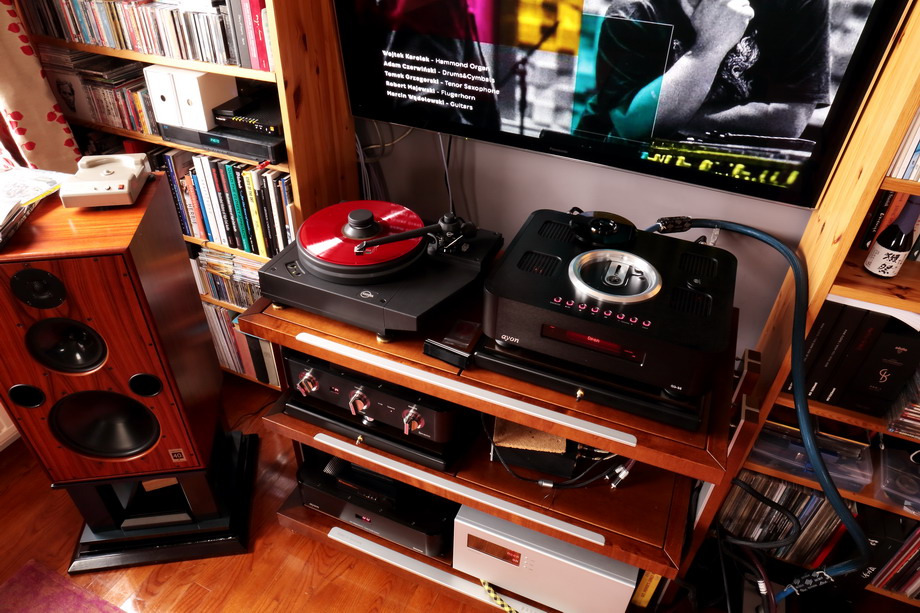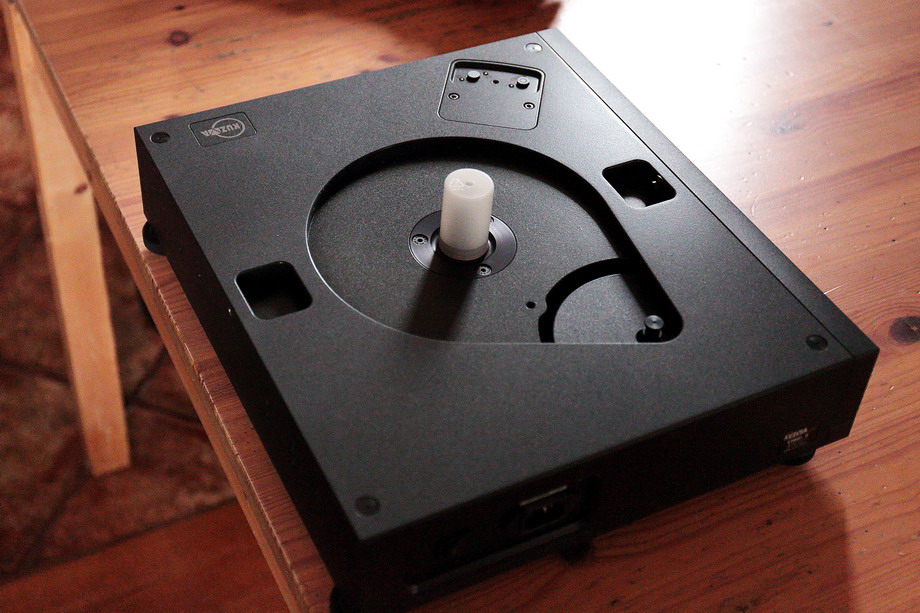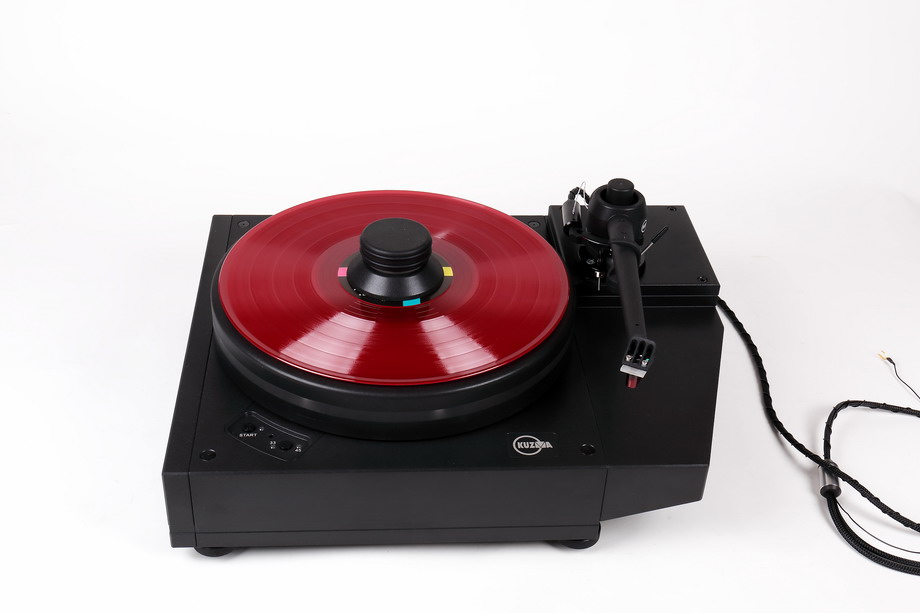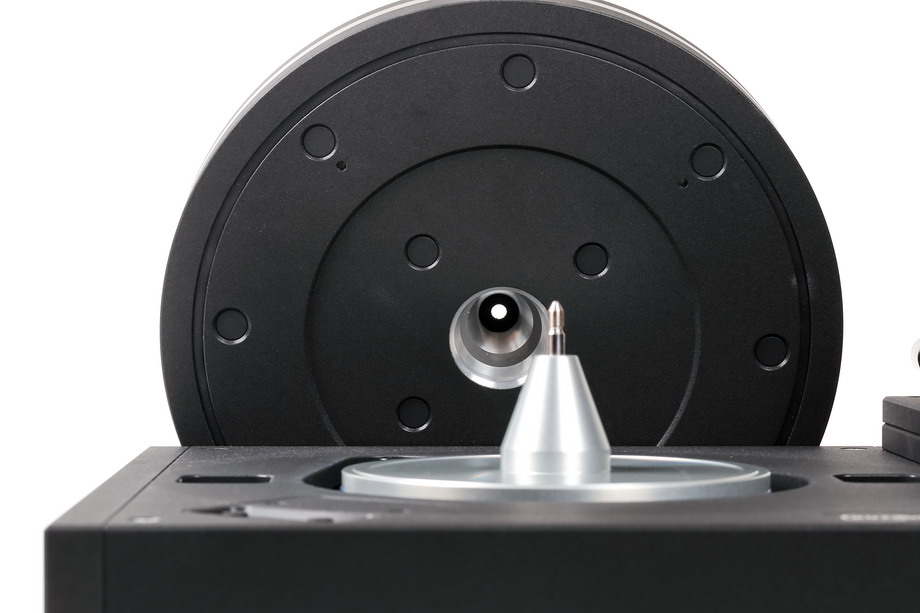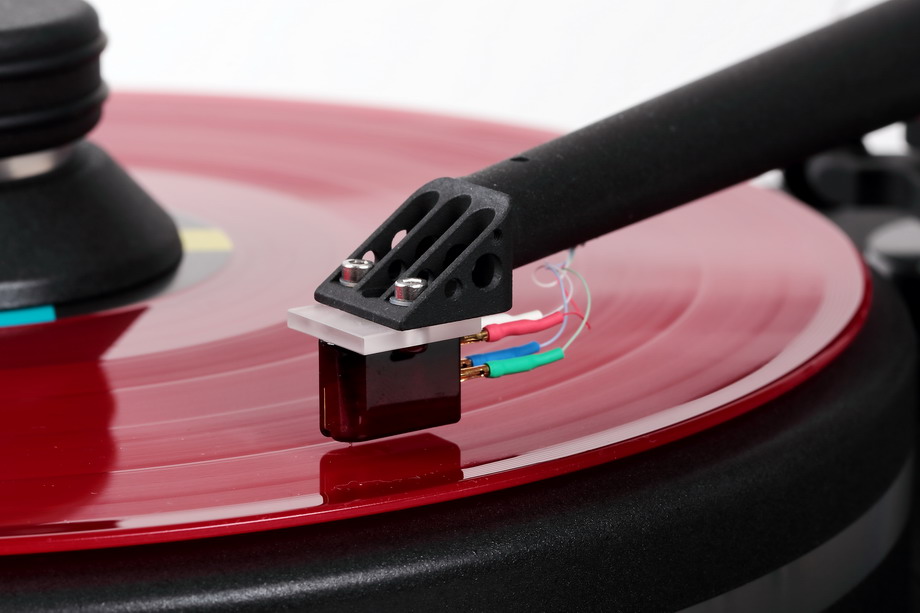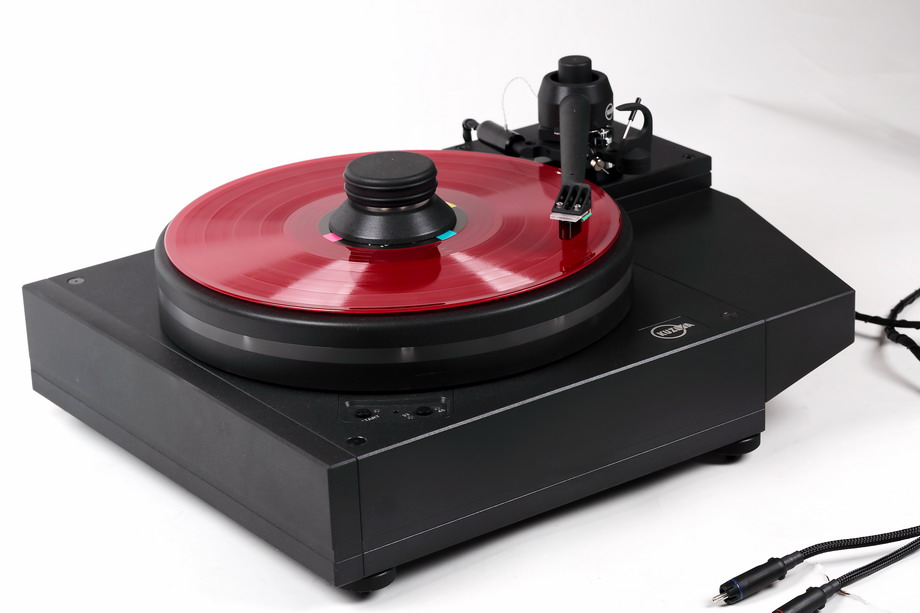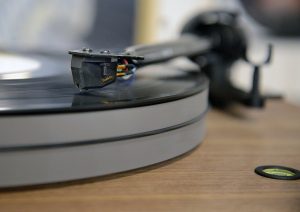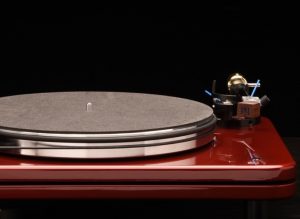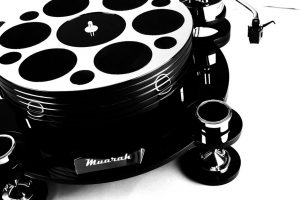The leitmotif of all turntables from the Slovenian company Kuzma is "less is better." Have a look at its iconic, "tubular" Stabi S turntable, to understand what it means—it's just two brass tubes with a platter and an outboard motor. Also tonearms designed by this brand, no less famous than turntables, look like a study of simplicity.
In fact, these are advanced, precise "measuring" systems, if I can say that. After all, in the turntables, a stylus constantly measures the geometry of the vinyl record's groove and converts this spatial structure to the corresponding voltage. Everything except a cartridge itself is used for its the most reliable operation/tracking. Frank Kuzma's, whose name is also the company's name, turntables and tonearms, are one of the best measuring instruments of this type.
STABI R
The Stabi R is its latest product. It is a mass-loader with a belt drive. It was conceived as a smaller version of the only decoupled turntable of this company, Stabi M. Its base has an almost square outline, in which it resembles classical transcription turntables used in radio studios on the one hand and the TechDAS Air Force III Premium turntable on the other.
There are several versions of the Kuzma R available. The Stabi R base, without any armboards, costs 26,300 PLN. When we add the so-called "arm wings," meaning a solid, heavy aluminum armboards, what we get is the Stabi R turntable for PLN 30,500. You can also add two outrigger aluminum armboards and this version called Stabi RD costs 33 600 PLN. And there is finally a wood version; Stabi R Wood for 30 500 PLN. It allows one to use only one tonearm, but the entire turntable is heavier by 6kg.
Its base has been made of a single block of aluminum and is really very heavy—the whole turntable, although quite small, weighs 36kg. It is not decoupled in any way, and the vibrations are to be extinguished using its large mass. It seems a very simple design at least until we see the way a motor has been mounted inside, or until we add tonearm bases to it. Yes, tonearms multiple, not just one, because—again I will refer to TechDAS—one can use up to four tonearms on it.
You can do it in two ways. One is using the classic tonearms bases, in this particular case they are called "balcony," screwed to the corners of the base—you can mount four such bases, designed for different length arms; 9, 10, and 12." And the second way is using bases I mentioned before, called "wings." They allow you to use two tonearms.
The DC motor in Stabi R is the same as used by Kuzma in their most expensive models. It is integrated with the base, and on aluminum disc mounted on its axis is hidden under the platter. The motor works with electronic power supply, which allows changing speed with a push of a button, same as starting and stopping the platter.
A torque is transferred from motor's axis to the sub-platter using a flat belt. It is made of a special, as manufacturer claims, virtually indestructible material. It is a drive mechanism developed initially for the top turntable, the Stabi XL DC. Platter riches nominal speed within 2 seconds.
One places a heavy, weighing 8 kg platter directly on a sub-platter It is a "sandwich" design constructed of three layers—aluminum, acrylic and aluminum—that already proved itself in the Ref 2 model. From the top it is covered with a specially impregnated, stiff fabric integrated with the plate. As an option, although a highly recommended one, you can use a screw-on record clamp. The platter spins on an inverted bearing featuring a 16mm in diameter steel shaft and a ruby ball. The ball and shaft operate in oil, which is applied during turntables assembly.
The turntable rests on four small, adjustable feet. They feature round tips, but it is worth placing them on some high quality pads.
HOW WE LISTENED TO IT
This has been the second time I listened to the Kuzma 4Point 9'' arm (PLN 15 300). I must say that it is one of the best tonearms on the market. This arm with an effective length of 229 mm and an effective weight of 13 g and it is extremely robust and extremely "repeatable," that is, it allows cartridges to present their own sonic characters.
This was the first tome though, that I listened to it combined with the Etsuro Urushi Bordeaux (32 000 PLN) MC cartridge. This is the most expensive pickup of this Japanese company with a super micro line 80 μm stylus. The stylus is mounted on a sapphire cantilever. The sapphire was also used for 2,5mm thick base, which screws are screwed to. The duralumin body has been beautifully finished using the Japanese technique called Urushi by a specialist Urushi Sakamoto Company.
As always, the turntable was placed on the top shelf of the Finite Elemente Pagode Edition rack and delivered signal to one of two phono preamplifiers: RCM Audio Sensor Prelude IC and GrandiNote Celio Mk IV.
KUZMA in High Fidelity
- TEST: Kuzma STABI S + PS + STOGI S 12 VTA turntable + power supply + tonearm
- TEST: Kuzma STABI XL2 + 4POINT turntable + tonearm
- TEST: Kuzma REFERENCE + STOGI REFERENCE 313 VTA turntable + power supply + tonearm
SOUND
Records used for the test (a selection):
- Smoke Sessions – Vol.1, Smoke Sessions Records SSR-1401, "Limited Edition Collection No. 193/500," 200 g LP (2013); review HERE
- Stereo Sound Reference Record Vol. 1, Universal Music LLC Stereo Sound SSAR-028~029, "Analog Record Collection," 2 x 180 g LP (2018)
- The Jazz Greats Volume III • Giant of Jazz Reeds-Part I, EmArcy MG 36050, LP (1955)
- Charlie Parker, Charlie Parker at Cafe Society 1950, Jazz Historical Recordings HR-138-EV, LP (1973)
- Johnny Hartman, I Just Dropped By To Say Hello, Impulse!/Original Recording Group ORG 027, 2 x 45 rpm, 180 g LP (1963/2013)
- Joscho Stephan Trio, Paris-Berlin, Berliner Meister Schallplatten BMS 1817 V, "Limited Edition No. 53," 180 g Direct-To-Disc, 180 g LP (2018)
- Katie Mahan, Katie Mahan plays Gershwin, Berliner Meister Schallplatten BMS 1706 V, "Limited Edition No. 479," 180 g Direct-To-Disc, 180 g LP (2018)
- Skalpel, Transit, PlugAudio PL02, 2 x 180 g LP (2014)
- Stan Getz & Charlie Byrd, Jazz Samba, Verve/Speakers Corner Records V6 8432, 180 g LP (1962/1998)
- U2, The Unforgettable Fire, Island 206 530-620, LP (1984)
Frank Kuzma's turntables have a common quality that you can recognize in almost every case, regardless of whether we are talking about the cheapest Stabi S, the most expensive Stabi XL DC or the reviewed Stabi R—it's how natural they are. They sound so organic, so smooth—but in the sense that there is no distortion that could distract listener—so fluidly that "natural sound" is the first phrase that comes to mind already when listening to the first record played on these turntables.
One can say that the Stabi R model is the case, where one could add another term to describe its sound—"analog." Seemingly simple, but... music lovers and audiophiles looking for an "analog ound" often do not know what they are really looking for. Based on stereotypes, exclamatory descriptions of audio products, and finally yielding to the ignorance of the so-called "experts" think that if something sounds warm, it means that it sounds analog. They include both sound sources and amplifiers to this group, and even cables.
Reality is not so simple, it's much more nuanced. Kuzma R sounds "analogue" not because it sounds warm although it does, not because it sounds smoothly although that's also true, but because it is incredibly intrinsically rich, saturated sound, there is a brilliant tone differentiation, it beautifully shows the depth of instruments and their volume, it is very resolving, though not super-selective, and also extremely dynamic. This is something that can be called an "analog sound."
The new Kuzma turntable presents this set of qualities with every record, a new and old ones, cut in direct-to-disc technique, from analogue tape and from a digital file. Importantly—it does not unify everything—it differentiates really well, which is also a feature of "analog sound". Each of the records I played had its own character, mood and aftertaste. But all of them had something in common, something that was "underneath," something like a motor upon which all the characteristic features of a particular record were overlayed.
After a few days I was sure that users of this turntable would be looking specifically for analogue releases - both the first releases and sophisticated re-issues. And this is because it is with them that the depth is deepest, and the smoothness is the smoothest, so to speak. This was the case with, for example, the excellent re-edition of Stan Getz & Charlie Byrd's Jazz Samba, which was released by the Speakers Corner, which had a velvety, beautiful tone, as well as with the original pressing of the The Jazz Greats Volume III • Giant of Jazz Reeds-Part I released by the EmArcy, that includes tracks with performances of such musicians as: Lester Young, Ben Webster, Coleman Hawkins and others.
I don't want to say that digital recordings released on vinyl sounded poorly. Let me put it this way—with Kuzma R they sounded nicer and more "analog,,in the common sense of the word, than with other turntables. So I could hear very well what is the "company" sound of the Smoke Sessions Records label and what still needed to be improved in them. This album sounded extremely dynamically, smoothly, nicely, but a little "thin", the bodies were not as richly filled as with analogue pressings.
And only the best pressings from digital files I know, for example the Stereo Sound Reference Record Vol. 1, a record released by Stereo Sound, sounded good enough, so that I preferred it from the same material released on a CD.
Perfect differentiation is one thing, but Kuzma R has its own sonic signature, there is no doubt about it. It's a warm sounding turntable. As I say, this is something other than the "analogue" sound. In this case the point is that the timbres are deepened and the center of gravity of colors is placed in the lower midrange. Perhaps that is why the sound has a huge momentum, and at the same time intimate closeness. The momentum provides a large volume and place to breath, and intimacy is manifested by a large, close foreground.
The sound is presented quite close to us at all. But we are not overwhelmed by it. This is one of the features of a high quality source—a sense of "presence" of the musicians and transferring the acoustics of recording to our room, a temporary suspension of our own acoustics. That how the Kuzma R performs. The close foreground is not aggressive, because within this closeness it has the right perspective.
It may seem a little confusing, but it is not—just listen to something like Johnny Hartman's I Just Dropped By To Say Hello, or Paris-Berlin by Joscho Stephan Trio to understand what I'm talking about. It is very dynamic, with a low center of gravity and dark (Joscho Stephan Trio) or very dark (Johnny Hartman). But we can see vocals and double bass from a distance, they do not sit on our lap, so to speak. This simultaneous sense of "here and now" and a perspective is something special and proves that Kuzma R with 4Point 9'' tonearm is a highly refined product.
Pulse and rhythm are another strengths of the reviewed turntable. However, this is not a rhythm as precise as I remember it from the Reference 2 and Stabi XL DC models, or that I know from the more expensive TechDAS turntables. It does not always have to be that way, but sometimes, as with the Depeche Mode club remixes, as with the samples from the Skalpel record, it should be a bit more accurate, more "forward." The thing is, I believe, in a warm and somewhat soft lower part of the band. I am talking about the range below 70-80 Hz. Nothing is missing in this sound, everything sounds beautiful. It simply does not offer an ultimate selectivity and precision.
Summary
Kuzma Stabi R is a compact, neat, fantastically sounding turntable. It performs beautifully with analog releases, but it is able to play also digital ones really well. Its tonality is based on lower midrange and upper bass, and the momentum of the sound is simply unique. The lower bass has a slightly warm character and it is not very precisely defined. The soundstage is large, almost huge, but never seems blown up. Despite all these features, poor recordings will still sound poor. The U2's The Unforgettable Fire from 1984 was, as usual, unlistenable. But performance with higher quality recordings was simply immersive.
Technical specifications (according to manufacturer)
- Weight: 36 kg
- Platter weight: 8 kg
- Driver: DC motor
- Speeds: 33 1/3, 45
- VTA adjustment: optional
- Number of tonearms: 1 (optionally up to 3)
- Suspended design: no
- Dimensions (W x D x H): 480 x 380 x 150 mm
- Base dimensions: 320 x 380 x 150 mm (30 kg)
- Wood version dimensions: 500 x 465 x 150 mm (39 kg)
- Finish: black or silver
- Record clamp: optional
- Power supply: 115/230/50-60 Hz
- Options: record clamp, different types of armboards, finish with one of RAL's colors
STABI R Turntable
Price (in Poland): 30 500 PLN
KUZMA Ltd.
Franc Kuzma Hotemaže 17/a
SI-4205 Preddvor Slovenia
MADE IN SLOVENIA
Provided for test by: RCM http://www.rcm.com.pl
Text: Wojciech Pacuła
Images: Wojciech Pacuła Kuzma
Translation: Marek Dyba




